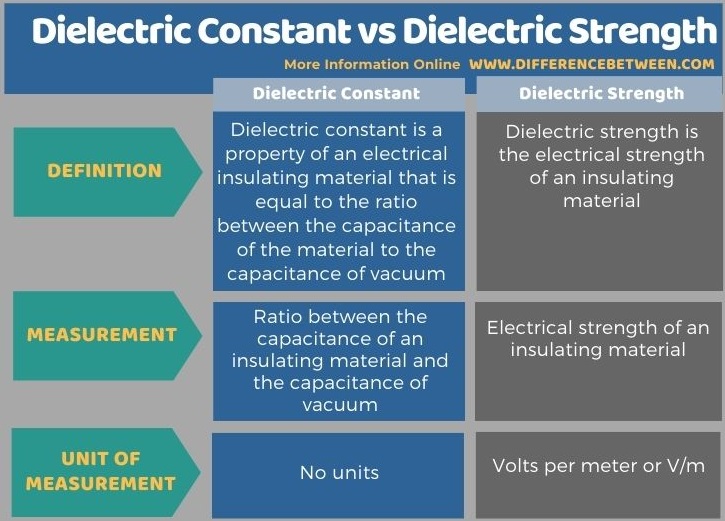Difference Between Dielectric Constant and Dielectric Strength
Table of Contents
The key difference between dielectric constant and dielectric strength is that dielectric constant is the ratio between the capacitance of an insulating material and the capacitance of vacuum whereas dielectric strength is the electrical strength of an insulating material.
Dielectric constant is a ratio and has no units of measurement while dielectric strength has the SI unit volts per meter or V/m. Moreover, dielectric strength is an intrinsic property of a particular insulating material.
CONTENT
1. Overview and Key Difference
2. What is Dielectric Constant
3. What is Dielectric Strength
4. Side by Side Comparison – Dielectric Constant and Dielectric Strength in Tabular Form
5. Summary
What is Dielectric Constant?
Dielectric constant is a property of an electrical insulating material that is equal to the ratio between the capacitance of the material to the capacitance of vacuum. Usually, we use the term dielectric constant interchangeably with the term “relative permittivity”, though they have slight differences. An electrical insulating material is known as a “dielectric”. In the definition of dielectric constant, the term capacitance of a material refers to the capacitance of a capacitor that is filled with the particular material. When determining the capacitance of the vacuum, it refers to the capacitance of an identical capacitor without dielectric material.

Figure 01: Wood is an Insulating Material
In a capacitor, there are parallel plates in between that can be filled with the dielectric material. Presence of a dielectric material between these two plates always increases the capacitance. That means it increases the ability of the capacitor to store opposite charges on each plate, compared to its ability to hold the charges when there is a vacuum between two plates. For the vacuum filled capacitor, the capacitance is considered to be one as a reference standard. Therefore, any dielectric material shows a dielectric constant that is more than one.
What is Dielectric Strength?
Dielectric strength is the electrical strength of an insulating material. However, there are two slightly different definitions for this term under the field of physics. When considering a pure electrically insulating material, dielectric strength is the maximum electric field the material can withstand under ideal conditions without undergoing any electrical breakdown. On the other hand, when considering the dielectric strength for a specific piece of a dielectric material and location of electrodes, dielectric constant is the minimum applied electric field that can result in its electric breakdown. The SI unit for the measurement of dielectric strength is volts per meter of V/m.
The dielectric strength of an insulating material is an intrinsic property of that bulk material that is independent of the configuration of that material. It is named as “the intrinsic dielectric strength”, and it corresponds to the measurement of the dielectric strength that is measured for a pure material under ideal laboratory conditions.
Several factors can affect the apparent dielectric strength. For example, dielectric strength decreases with increased sample thickness, it decreases with increased operating temperature, it decreases with increased frequency, it tends to decrease with increased humidity (this factor is for gases), etc.
What is the Difference Between Dielectric Constant and Dielectric Strength?
Dielectric constant and dielectric strength are two different terms. The key difference between dielectric constant and dielectric strength is that dielectric constant is the ratio between capacitance of an insulating material and the capacitance of vacuum whereas dielectric strength is the electrical strength of an insulating material.
Below infographic summarizes the differences between dielectric constant and dielectric strength in tabular form.

Summary – Dielectric Constant vs Dielectric Strength
Dielectric constant is a property of an electrical insulating material that is equal to the ratio between the capacitance of the material to the capacitance of vacuum. Dielectric strength is the electrical strength of an insulating material. Therefore, the key difference between dielectric constant and dielectric strength is that dielectric constant is the ratio between the capacitance of an insulating material and the capacitance of vacuum whereas dielectric strength is the electrical strength of an insulating material.
Reference:
1. “Dielectric Strength.” Science Direct, Available here.
Image Courtesy:
1. “16 wood samples” By Anonimski – Own work (CC0) via Commons Wikimedia
ncG1vNJzZmivp6x7pbXFn5yrnZ6YsqOx07CcnqZemLyue8OinZ%2Bdopq7pLGMm5ytr5Wau26wyJ6jnpukp7akecKopayskaPBbq3NnWSdoZWhsqTA0aKaZqukp7Kvs9OhZg%3D%3D